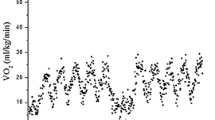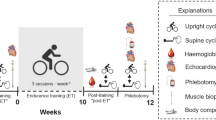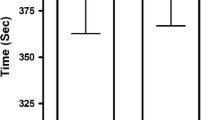Abstract
We sought to determine whether improved cycling performance following ‘Live High-Train Low’ (LHTL) occurs if increases in haemoglobin mass (Hbmass) are prevented via periodic phlebotomy during hypoxic exposure. Eleven, highly trained, female cyclists completed 26 nights of simulated LHTL (16 h day−1, 3000 m). Hbmass was determined in quadruplicate before LHTL and in duplicate weekly thereafter. After 14 nights, cyclists were pair-matched, based on their Hbmass response (ΔHbmass) from baseline, to form a response group (Response, n = 5) in which Hbmass was free to adapt, and a Clamp group (Clamp, n = 6) in which ΔHbmass was negated via weekly phlebotomy. All cyclists were blinded to the blood volume removed. Cycling performance was assessed in duplicate before and after LHTL using a maximal 4-min effort (MMP4min) followed by a ride time to exhaustion test at peak power output (T lim). VO2peak was established during the MMP4min. Following LHTL, Hbmass increased in Response (mean ± SD, 5.5 ± 2.9%). Due to repeated phlebotomy, there was no ΔHbmass in Clamp (−0.4 ± 0.6%). VO2peak increased in Response (3.5 ± 2.3%) but not in Clamp (0.3 ± 2.6%). MMP4min improved in both the groups (Response 4.5 ± 1.1%, Clamp 3.6 ± 1.4%) and was not different between groups (p = 0.58). T lim increased only in Response, with Clamp substantially worse than Response (−37.6%; 90% CL −58.9 to −5.0, p = 0.07). Our novel findings, showing an ~4% increase in MMP4min despite blocking an ~5% increase in Hbmass, suggest that accelerated erythropoiesis is not the sole mechanism by which LHTL improves performance. However, increases in Hbmass appear to influence the aerobic contribution to high-intensity exercise which may be important for subsequent high-intensity efforts.



Similar content being viewed by others

References
Ahlgrim C, Pottgiesser T, Robinson N, Sottas PE, Ruecker G, Schumacher YO (2010) Are 10 min of seating enough to guarantee stable haemoglobin and haematocrit readings for the athlete’s biological passport? Int J Lab Hematol 32(5):506–511
Allen H, Coggan A (2006) Training and racing with a power meter. Velo Press, Boulder
Bangsbo J, Michalsik L, Petersen A (1993) Accumulated O2 deficit during intense exercise and muscle characteristics of elite athletes. Int J Sports Med 14:207–213
Banister EW, Calvert TW (1980) Planning for future performance: implications for long term training. Can J Appl Sport Sci 5:170–176
Berglund B, Hemmingson P (1987) Effect of reinfusion of autologous blood on exercise performance in cross-country skiers. Int J Sports Med 8:231–233
Bonetti DL, Hopkins WG (2009) Sea-level exercise performance following adaptation to hypoxia: a meta-analysis. Sports Med 39:107–127
Brien AJ, Simon TL (1987) The effects of red blood cell infusion on 10-km race time. JAMA 257:2761–2765
Brosnan MJ, Martin DT, Hahn AG, Gore CJ, Hawley JA (2000) Impaired interval exercise responses in elite female cyclists at moderate simulated altitude. J Appl Physiol 89:1819–1824
Chaplin H Jr, Mollison PL, Vetter H (1953) The body/venous hematocrit ratio: its constancy over a wide hematocrit range. J Clin Invest 32:1309–1316
Clark SA, Quod MJ, Clark MA, Martin DT, Saunders PU, Gore CJ (2009) Time course of haemoglobin mass during 21 days live high:train low simulated altitude. Eur J Appl Physiol 106:399–406
Cohen J (1988) Statistical power analysis for the behavioural sciences. Lawrence Erlbaum Associates, Hillsdale
Craig NP, Norton KI, Bourdon PC, Woolford SM, Stanef T, Squires B, Olds TS, Conyers RA, Walsh CB (1993) Aerobic and anaerobic indices contributing to track endurance cycling performance. Eur J Appl Physiol Occup Physiol 67:150–158
Ebert TR, Martin DT, McDonald W, Victor J, Plummer J, Withers RT (2005) Power output during women’s World Cup road cycle racing. Eur J Appl Physiol 95:529–536
Ekblom B (1996) Blood doping and erythropoietin. The effects of variation in hemoglobin concentration and other related factors on physical performance. Am J Sports Med 24:S40–S42
Ekblom B, Huot R (1972) Response to submaximal and maximal exercise at different levels of carboxyhemoglobin. Acta Physiol Scand 86:474–482
Friedmann-Bette B (2008) Classical altitude training. Scand J Med Sci Sports 18(Suppl 1):11–20
Gardner AS, Stephens S, Martin DT, Lawton E, Lee H, Jenkins D (2004) Accuracy of SRM and power tap power monitoring systems for bicycling. Med Sci Sports Exerc 36:1252–1258
Garry DJ, Ordway GA, Lorenz JN, Radford NB, Chin ER, Grange RW, Bassel-Duby R, Williams RS (1998) Mice without myoglobin. Nature 395:905–908
Gastin PB (2001) Energy system interaction and relative contribution during maximal exercise. Sports Med 31:725–741
Gledhill N, Warburton D, Jamnik V (1999) Haemoglobin, blood volume, cardiac function, and aerobic power. Can J Appl Physiol 24:54–65
Gore CJ, Hopkins WG (2005) Counterpoint: positive effects of intermittent hypoxia (live high:train low) on exercise performance are not mediated primarily by augmented red cell volume. J Appl Physiol 99:2055–2057 discussion 2057–2058
Gore CJ, Hahn A, Rice A, Bourdon P, Lawrence S, Walsh C, Stanef T, Barnes P, Parisotto R, Martin D, Pyne D (1998) Altitude training at 2690 m does not increase total haemoglobin mass or sea level VO2max in world champion track cyclists. J Sci Med Sport 1:156–170
Gore CJ, Hahn AG, Aughey RJ, Martin DT, Ashenden MJ, Clark SA, Garnham AP, Roberts AD, Slater GJ, McKenna MJ (2001) Live high:train low increases muscle buffer capacity and submaximal cycling efficiency. Acta Physiol Scand 173:275–286
Gore CJ, Clark SA, Saunders PU (2007) Nonhematological mechanisms of improved sea-level performance after hypoxic exposure. Med Sci Sports Exerc 39:1600–1609
Hopkins WG (2000) Measures of reliability in sports medicine and science. Sports Med 30:1–15
Hopkins WG, Hawley JA, Burke LM (1999) Design and analysis of research on sport performance enhancement. Med Sci Sports Exerc 31:472–485
Hopkins WG, Marshall SW, Batterham AM, Hanin J (2009) Progressive statistics for studies in sports medicine and exercise science. Med Sci Sports Exerc 41:3–13
Kanstrup IL, Ekblom B (1984) Blood volume and hemoglobin concentration as determinants of maximal aerobic power. Med Sci Sports Exerc 16:256–262
Kuipers H, Verstappen FT, Keizer HA, Geurten P, van Kranenburg G (1985) Variability of aerobic performance in the laboratory and its physiologic correlates. Int J Sports Med 6:197–201
Levine BD, Stray-Gundersen J (1997) “Living high-training low”: effect of moderate-altitude acclimatization with low-altitude training on performance. J Appl Physiol 83:102–112
Levine BD, Stray-Gundersen J (2005) Point: positive effects of intermittent hypoxia (live high:train low) on exercise performance are mediated primarily by augmented red cell volume. J Appl Physiol 99:2053–2055
Levine BD, Stray-Gundersen J (2006) Dose-response of altitude training: how much altitude is enough? Adv Exp Med Biol 588:233–247
Medbo JI, Mohn AC, Tabata I, Bahr R, Vaage O, Sejersted OM (1988) Anaerobic capacity determined by maximal accumulated O2 deficit. J Appl Physiol 64:50–60
Meeusen R, Nederhof E, Buyse L, Roelands B, De Schutter G, Piacentini MF (2008) Diagnosing overtraining in athletes using the two bout exercise protocol. Br J Sports Med 44(9):642–648
Millet GP, Roels B, Schmitt L, Woorons X, Richalet JP (2010) Combining hypoxic methods for peak performance. Sports Med 40:1–25
Mizuno M, Juel C, Bro-Rasmussen T, Mygind E, Schibye B, Rasmussen B, Saltin B (1990) Limb skeletal muscle adaptation in athletes after training at altitude. J Appl Physiol 68:496–502
Roberts AD, Clark SA, Townsend NE, Anderson ME, Gore CJ, Hahn AG (2003) Changes in performance, maximal oxygen uptake and maximal accumulated oxygen deficit after 5, 10 and 15 days of live high:train low altitude exposure. Eur J Appl Physiol 88:390–395
Robertson EY, Saunders PU, Pyne DB, Aughey RJ, Anson JM, Gore CJ (2010) Reproducibility of performance changes to simulated live high/train low altitude. Med Sci Sports Exerc 42:394–401
Sasaki R, Masuda S, Nagao M (2000) Erythropoietin: multiple physiological functions and regulation of biosynthesis. Biosci Biotechnol Biochem 64:1775–1793
Saunders PU, Telford RD, Pyne DB, Cunningham RB, Gore CJ, Hahn AG, Hawley JA (2004) Improved running economy in elite runners after 20 days of simulated moderate-altitude exposure. J Appl Physiol 96:931–937
Schmidt W, Prommer N (2005) The optimised CO-rebreathing method: a new tool to determine total haemoglobin mass routinely. Eur J Appl Physiol 95:486–495
Schmidt W, Prommer N (2010) Impact of alterations in total hemoglobin mass on VO 2max. Exerc Sport Sci Rev 38:68–75
Schumacher YO, Roecker K (2006) Comment on point: counterpoint “in health and in a normoxic environment, VO2max is/is not limited primarily by cardiac output and locomotor muscle blood flow”. Vol 100: 744–8, 2006. Discrete, well-developed components may be able to compensate for weaker ones. J Appl Physiol 100:1086–1087
Schumacher YO, Pottgiesser T, Ahlgrim C, Ruthardt S, Dickhuth HH, Roecker K (2008) Haemoglobin mass in cyclists during stage racing. Int J Sports Med 29:372–378
Wagner PD (1996) Determinants of maximal oxygen transport and utilization. Annu Rev Physiol 58:21–50
Zoll J, Ponsot E, Dufour S, Doutreleau S, Ventura-Clapier R, Vogt M, Hoppeler H, Richard R, Fluck M (2006) Exercise training in normobaric hypoxia in endurance runners. III. Muscular adjustments of selected gene transcripts. J Appl Physiol 100:1258–1266
Acknowledgments
The authors gratefully acknowledge the work and support of the staff and students of the AIS Physiology Department, particularly the work of Marilyn Dickson, Nicole Thomas, and Jamie Plowman. The authors would also like to thank Amanda Spratt, Dave McPartland and Beth Duryea for their valuable assistance in the conduct of the study and the riders for their efforts during training and testing. This study was funded by a General and Collaborative Research Grant awarded by the Performance Research Centre at the Australian Institute of Sport. Grants and financial support were received from Applied Research Centre at the Australian Institute of Sport and the University Hospital of Freiburg.
Conflict of interest
None.
Author information
Authors and Affiliations
Corresponding author
Additional information
Communicated by Susan Ward.
Rights and permissions
About this article
Cite this article
Garvican, L.A., Pottgiesser, T., Martin, D.T. et al. The contribution of haemoglobin mass to increases in cycling performance induced by simulated LHTL. Eur J Appl Physiol 111, 1089–1101 (2011). https://doi.org/10.1007/s00421-010-1732-z
Accepted:
Published:
Issue Date:
DOI: https://doi.org/10.1007/s00421-010-1732-z



